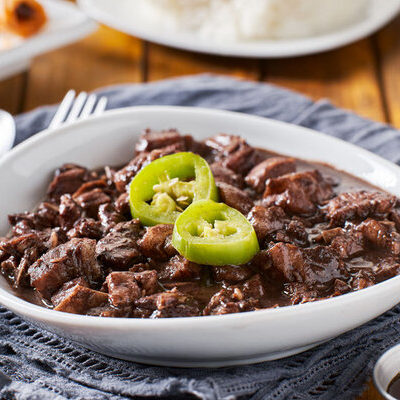
Dinuguan
What is Dinuguan?
Dinuguan is a Filipino dish that is made with pork offal and pig’s blood in the form of a stew. The dish may include lungs, kidneys, intestines, ears, hearts, and the snouts of pigs. The word itself means “bloody” in Filipino, although dinuguan is known as dugo-dugo in Cebu and dinardaraan in Ilocos.
The best restaurants serving dinuguan in Manila are:
- Kanin Club
- Lydia’s Lechon
- Banang’s
- Goldilocks
- Rodic’s
- Razon’s
- Jay-J’s Inasal
- Chicken Bacolod Inasal
- Kamay Kainan
- Red Ribbon
Origin of dinuguan
There is not much information regarding this dish’s origins. Nonetheless, some believe that it was brought by the Spanish colonists since there are similar dishes in other Spanish colonies, such as Mexico and Guam. However, many historians lean towards it being a dish indigenous to the Philippines. According to one story, it was created because the Filipinos had no access to good meat during the colonial period. It is believed that this dish was created to salvage all parts of the slaughtered animal due to lack of refrigeration.
Nutrition
Pork offal, which is the main ingredient, is considered a byproduct and is rich in nutrients, even more so than the muscular tissues. Offal contains B vitamins such as B1, B2, B6, and folic acid as well as proteins, minerals, and fats, alongside essential polyunsaturated fats and amino acids. Pig’s blood is a rich source of iron and vitamin K, but one must be very careful to check its source as pig’s blood can also cause several diseases including Streptococcus suis. Vinegar, used to remove the smell of the offal and blood, may have cancer-reducing properties and may also reduce hypertension and manage diabetes. As a whole, it is a rich and nutrient-filled dish that may be consumed in moderation.
Commercial production
Dinuguan is a versatile dish that is prepared with different recipes in different restaurants. It is a very common dish in the Philippines and can be found in almost every restaurant. The dish is often eaten with rice or steamed rice cakes known as puto. The dish is commonly prepared on festive occasions in the Philippines.
Dinuguan recipes
This dish may have different variations but the basic ingredients remain the same. Here are a few recipes:
FDA regulations
The USDA classifies offal (lungs, kidneys, intestines, ears, heart, snout, etc.) as animal byproducts. They are considered edible and are regulated. The offal must come from animals that are healthy when slaughtered to prevent salmonella, E.coli, and other infections.
References
Villa, Ninah, and Libia Chavez. “Dinuguan Origins and Regional Variations in the Philippines.” Pinoy Wit, Pinoy Wit, 17 Oct. 2020, www.pinoywit.com/dinuguan-origins-regional-variations-philippines/.
Biel, Wioletta et al. “Offal Chemical Composition from Veal, Beef, and Lamb Maintained in Organic Production Systems.” Animals : an open access journal from MDPI vol. 9,8 489. 26 Jul. 2019, doi:10.3390/ani9080489
https://www.ncbi.nlm.nih.gov/pmc/articles/PMC6721235/
Johnston, Carol S, and Cindy A Gaas. “Vinegar: medicinal uses and antiglycemic effect.” MedGenMed : Medscape general medicine vol. 8,2 61. 30 May. 2006
https://www.ncbi.nlm.nih.gov/pmc/articles/PMC1785201/
USDA Modernizes Swine Slaughter Inspection for the First Time in Over 50 Years.” USDA, USDA, 17 Sept. 2019, www.usda.gov/media/press-releases/2019/09/17/usda-modernizes-swine-slaughter-inspection-first-time-over-50-years.
